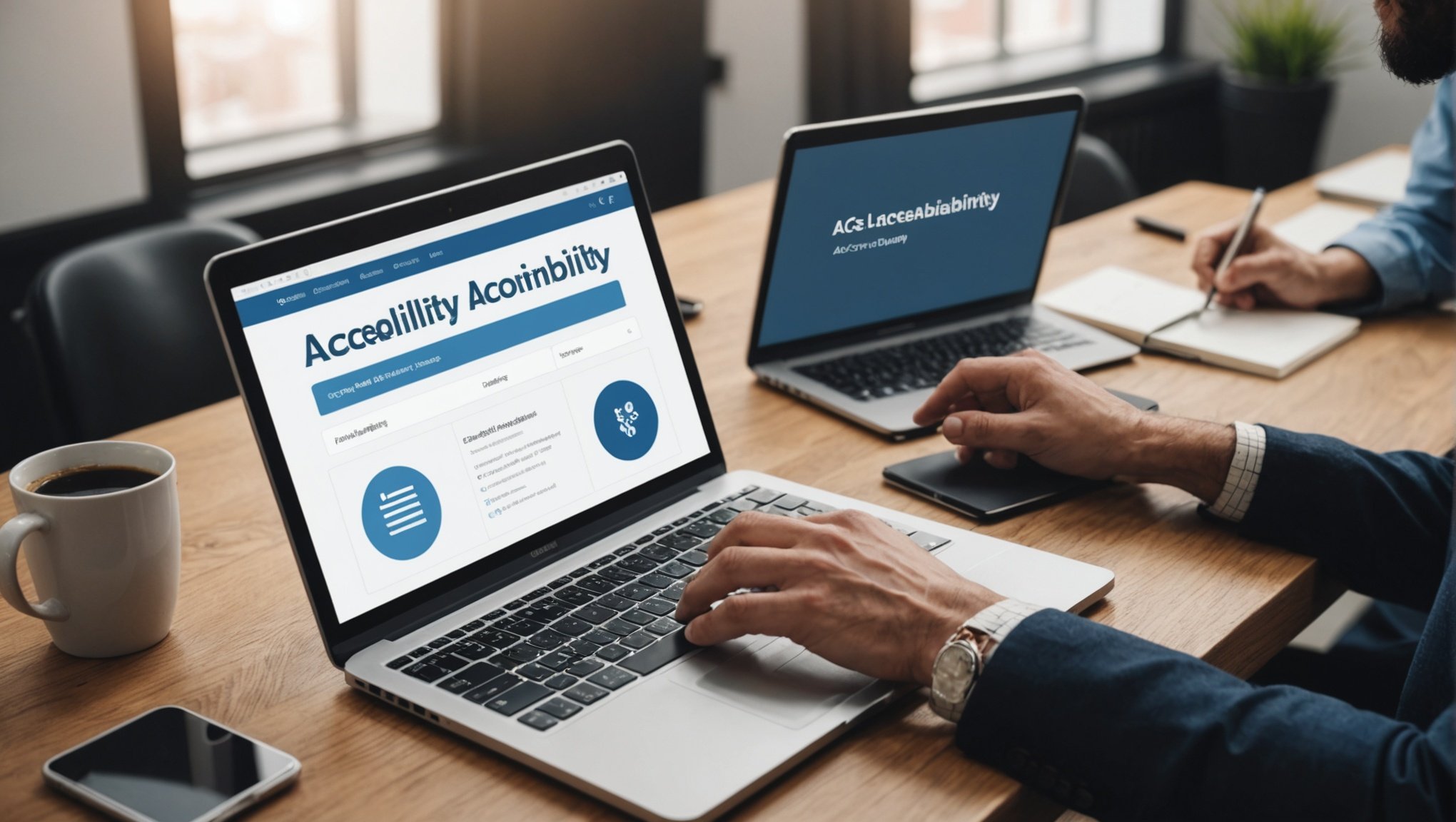Online learning platforms in the UK face the pressing challenge of ensuring accessibility compliance. Meeting legal requirements not only promotes inclusivity but also enhances user engagement and satisfaction. This guide offers essential strategies for creating accessible content and navigating the complexities of UK regulations. Discover practical tips, valuable insights, and real-world examples to help your platform succeed in fostering an inclusive learning environment for everyone.
Understanding Accessibility Compliance in the UK
In the UK, accessibility compliance is governed by laws such as the Equality Act 2010 and the Public Sector Bodies (Websites and Mobile Applications) Accessibility Regulations 2018. These regulations ensure that digital content is accessible to everyone, including individuals with disabilities. This extends to online learning platforms, which must adhere to these standards to provide inclusive education.
Topic to read : Ensuring Compliance: A Guide for UK Virtual Assistant Services on Navigating Remote Work Regulations
Accessibility compliance in the UK is crucial for promoting equality and preventing discrimination. It ensures that all users, regardless of their abilities, can access and benefit from digital content. This is particularly important in online learning, where students rely on digital platforms for their education. By adhering to accessibility standards, educational institutions can create an inclusive learning environment that accommodates diverse needs.
Key concepts related to accessibility include perceivability, operability, understandability, and robustness. These principles guide the creation of accessible content, ensuring that it is usable by everyone. For instance, perceivability ensures that information is presented in a way that users can perceive, such as providing text alternatives for images.
Also to discover : Essential Guide to Navigating UK Regulations for Launching Your Plant-Based Milk Production Facility
In summary, accessibility compliance in the UK is essential for creating inclusive digital spaces, particularly in the realm of online learning. By understanding and implementing these laws and concepts, organisations can ensure that their platforms are accessible to all users.
Legal Requirements for Online Learning Platforms
Navigating the legal requirements for online learning platforms in the UK involves understanding critical legislation like the Equality Act 2010 and the Web Content Accessibility Guidelines (WCAG). The Equality Act 2010 mandates that all digital services, including educational platforms, must be accessible to individuals with disabilities, ensuring equal access and preventing discrimination. This law is pivotal in promoting inclusivity within digital spaces, particularly in education.
The WCAG standards are a set of guidelines designed to ensure web content is accessible to all users. They outline principles for creating perceivable, operable, understandable, and robust content. Educational institutions must adhere to these standards to provide an inclusive learning environment. Compliance with WCAG not only supports legal adherence but also enhances the user experience for everyone.
Failing to meet these legal requirements can result in significant consequences for educational institutions. Non-compliance may lead to legal action, reputational damage, and financial penalties. More importantly, it can alienate students who rely on accessible digital content for their education. Therefore, embracing these standards is not just a legal obligation but a commitment to fostering an inclusive and equitable educational landscape.
Best Practices for Creating Accessible Content
Creating accessible content is vital in ensuring that digital platforms are inclusive and equitable. By following best practices rooted in universal design principles, online learning environments can be made accessible to all users, including those with disabilities.
Principles of Universal Design
The principles of universal design focus on creating content that is usable by everyone, regardless of ability. This involves ensuring that all information is presented in a way that is perceivable, operable, understandable, and robust. By integrating these principles into the design process, educational platforms can enhance accessibility and user experience.
Techniques for Accessible Content
To create accessible documents, videos, and websites, several techniques should be employed:
- Alt Text: Providing descriptive alternative text for images ensures that visual content is accessible to users who rely on screen readers.
- Captions: Adding captions to videos makes auditory content accessible to individuals who are deaf or hard of hearing.
- Keyboard Navigation: Ensuring that websites can be navigated using a keyboard is crucial for users with mobility impairments.
By incorporating these techniques, educational institutions can ensure that their digital content is accessible to a wider audience, fostering an inclusive learning environment.
Tools for Assessing Accessibility
Ensuring digital content is accessible requires the use of effective accessibility tools for evaluation and assessment. These tools aid in identifying and rectifying accessibility issues within online learning platforms and other digital spaces.
Overview of Popular Accessibility Evaluation Tools
Several accessibility tools are widely recognised for their efficiency and ease of use. WAVE (Web Accessibility Evaluation Tool) provides a visual representation of accessibility issues directly on web pages. AXE, another robust tool, offers automated testing capabilities that integrate seamlessly with development environments. Lighthouse, a tool developed by Google, provides insights into accessibility alongside performance and SEO metrics.
Step-by-Step Guide to Conducting Accessibility Assessments
Conducting an accessibility assessment involves several key steps:
- Initial Evaluation: Use automated tools to identify obvious issues.
- Manual Testing: Engage users with disabilities to test content usability.
- Review and Rectify: Address identified issues, focusing on areas like keyboard navigation and alt text.
Integrating Accessibility Checks into the Content Creation Process
Incorporating accessibility checks during content creation is crucial. This includes regular use of accessibility tools to evaluate new content and updating existing materials. By embedding these checks into the workflow, organisations can ensure ongoing compliance and inclusivity.
Examples of Accessible Online Learning Materials
Exploring accessible learning materials reveals how educational institutions are excelling in creating inclusive environments. By examining case studies, we can understand the successful implementation of these materials.
Case Studies in Accessibility
Case studies provide valuable insights into how institutions have effectively integrated accessibility. For instance, the University of York implemented a comprehensive accessibility strategy, focusing on providing resources like screen readers and captioned videos. This approach not only enhanced the learning experience for students with disabilities but also improved overall engagement.
Accessible Course Design and Delivery
Examples of accessible course design include using resources such as interactive transcripts for video content and providing course materials in multiple formats. The Open University is renowned for its commitment to accessibility, offering courses that incorporate these elements to cater to diverse learning needs.
Insights from Leading Institutions
Institutions like the University of Edinburgh have set benchmarks in accessibility by continuously updating their digital platforms and training staff on best practices. Their focus on accessible learning materials ensures that all students, regardless of ability, have equal opportunities to succeed. These examples underscore the importance of commitment and innovation in fostering an inclusive educational landscape.
Addressing Diverse Disabilities
In the realm of inclusive education, addressing the needs of individuals with various disabilities is paramount. Each disability presents unique accessibility challenges that must be met to ensure equitable access to online learning platforms. Disabilities can range from visual and auditory impairments to cognitive and mobility challenges, each requiring tailored strategies for effective accommodation.
Overview of Various Disabilities
Understanding the spectrum of disabilities is essential. Visual impairments may necessitate screen readers or text-to-speech options, while auditory disabilities often require captioning or sign language interpretation. Cognitive disabilities might benefit from simplified content and clear navigation, whereas mobility impairments may require keyboard accessibility and voice commands.
Strategies for Accommodating Different Learning Needs
To address these accessibility challenges, online platforms should implement a variety of strategies. These include:
- Providing multiple formats for learning materials to cater to different needs.
- Ensuring compatibility with assistive technologies.
- Offering customisable interfaces to enhance usability.
Importance of User Feedback
User feedback is invaluable in refining accessibility features. Engaging with users who have disabilities allows developers to gain insights into real-world challenges and improve platform inclusivity. This iterative process ensures that online learning environments continuously evolve to meet diverse needs, fostering a truly inclusive educational experience.
Ongoing Education and Updates in Accessibility Standards
In the dynamic field of accessibility compliance, staying informed through continuous learning is essential. Resources for ongoing education play a vital role in equipping individuals and organisations with the knowledge needed to maintain compliance. These resources include online courses, webinars, and workshops that cover the latest accessibility standards and best practices.
The importance of staying updated on legal and technological changes cannot be overstated. As laws and technologies evolve, so do the requirements for accessibility. Regular updates ensure that digital platforms remain inclusive and compliant with current regulations. Engaging in accessibility training helps professionals understand these changes and implement necessary adjustments effectively.
Networking opportunities are also crucial for those involved in accessibility. Participating in communities focused on accessibility, such as forums and professional networks, provides valuable insights and support. These platforms facilitate the exchange of ideas and experiences, fostering a collaborative approach to solving accessibility challenges.
By embracing continuous learning and leveraging available resources, individuals and organisations can ensure they are well-equipped to navigate the complexities of accessibility standards. This proactive approach not only enhances compliance but also contributes to a more inclusive digital environment.
Building a Culture of Accessibility in Online Learning
Creating an Accessibility Culture within educational institutions is essential for fostering inclusivity. This involves a comprehensive approach, integrating best practices and ensuring institutional commitment to accessibility.
Strategies for Fostering an Inclusive Environment
To cultivate an inclusive environment, institutions should implement strategies that prioritise accessibility. This includes developing policies that mandate accessible content creation and providing training for faculty and staff. These measures ensure that accessibility becomes a fundamental aspect of the institution's operations, rather than an afterthought.
Role of Leadership in Promoting Accessibility Initiatives
Leadership plays a pivotal role in promoting accessibility initiatives. By demonstrating a commitment to inclusivity, leaders can inspire others within the institution to prioritise accessibility. This involves allocating resources for accessibility improvements and recognising efforts made by faculty and staff to enhance accessibility.
Encouraging Collaboration Among Faculty, Staff, and Students
Collaboration is key to building a robust Accessibility Culture. Encouraging faculty, staff, and students to work together on accessibility efforts can lead to innovative solutions and a more inclusive learning environment. This collaboration can be facilitated through workshops, committees, and feedback sessions, where all stakeholders can contribute their insights and experiences.











